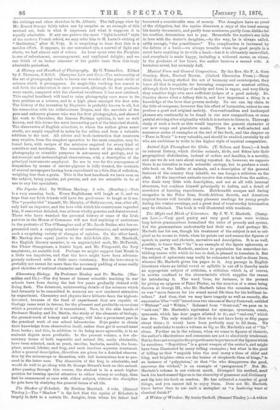The Might and Mirth of Literature. By J. W. V.
Macbeth. (Samp- son Low.)—Very good poetry and very good prose were written long before grammarians formalised the rules of prosody and syntax. Yet the grammarians undoubtedly had their use. And perhaps Mr. Macbeth has his use, though his treatment of the subject is not so ori- ginal as he seems to think, when he points out and names the figures of speech in poetry and rhetoric, narrative and description. It is as well, possibly, to know that" 'tis" is an example of the figure aplueresis, or "front-cut," as Mr. Macbeth, anxious to popularise the somewhat for- bidding names with which he has to deal, is pleased to translate it. But the subject of aphasresis may really be exhausted in half-a-dozen lines, whereas Mr. Macbeth gives ten pages to it. Any passage in English literature where an initial vowel or syllable is cut off is thereby made an appropriate subject of criticism, a criticism which is, of course, in nowise confined to the characteristic which supplies the reason for introducing it. The word 'twas, for instance, is the pretext for giving an epigram of Peter Pinder, on the occasion of a stone being thrown at George Ill., who Mr. Macbeth takes the occasion to inform us was "more famous for his sound moral life than for his brilliant in- tellect." And then, that we may have tragedy as well as comedy, the expression 7/ for will" introduces two stanzas of Barry Cornwall, entitled "Without" and "Within." Released from "front-cut," we pass on to "mid-cut," Mr. Macbeth's equivalent for syncope, synaereais, crasis, synezesis, which has four pages allotted to it ; and "end-cut," which has five. The only wonder is that we do not have forty or fifty pagan about them ; it would have been perfectly easy to fill them. We- would undertake to make a volume as big as Mr. Macbeth's out of "tie" alone. Further en in the volume, when we come to figures of rhetoric, the author's illustrations and comments are not so absolutely irrelevant. But he does not recognise the proportionate importance of the figures whieh he mentions. "Repetition" is a great weapon of the orator's, and might have been illustrated by many telling examples ; but what is the good of telling us that "anguish tries the soul many a time of chief and king, and brighter often are the brains of shepherds than of kings," is an instance of ' polyptoton,' or that "ho who disapproves the good, approves the wicked," is an example of paregmenon ?' But Mr. Macbeth's volume is not without merit. Disregard his method, send back his hard-named figures to the obscurity of grammar and dictionary and dip into his book at random. He has collected a number of good things, and you cannot fail to enjoy them. Does not Mr. Macbeth know better than to use such a metaphor as "a lumbering want of classical finish ?"


































 Previous page
Previous page